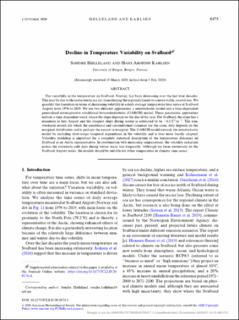| dc.description.abstract | The variability in the temperature on Svalbard, Norway, has been decreasing over the last four decades. This may be due to the reduction in sea ice, transitioning the regional climate to a more stable, coastal one.We quantify this transition in terms of decreasing volatility in a daily average temperature time series at Svalbard Airport from 1976 to 2019. We use two different approaches: a nonstochastic model and a time-dependent generalized autoregressive conditional heteroskedasticity (GARCH) model. These parametric approaches include a time-dependent trend, where the slope depends on the day of the year. For Svalbard, the slope has a minimum in late August and the steepest slope during winter is estimated to be 20.18C2 yr21. The nonstochastic model, for which the conditional and unconditional variances are the same, only depends on the marginal distribution and is perhaps the easiest to interpret. The GARCH model extends the nonstochastic model by including short-range temporal dependence in the volatility and is thus more locally adapted. Volatility modeling is important for a complete statistical description of the temperature dynamics on Svalbard as an Arctic representative. In combination with increasing temperatures, the volatility reduction makes the extremely cold days during winter occur less frequently. Although we focus exclusively on the Svalbard Airport series, the models should be suitable for other temperature or climatic time series. | en_US |
